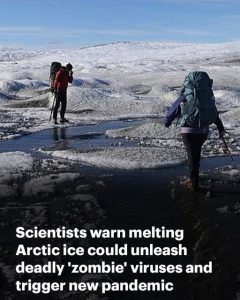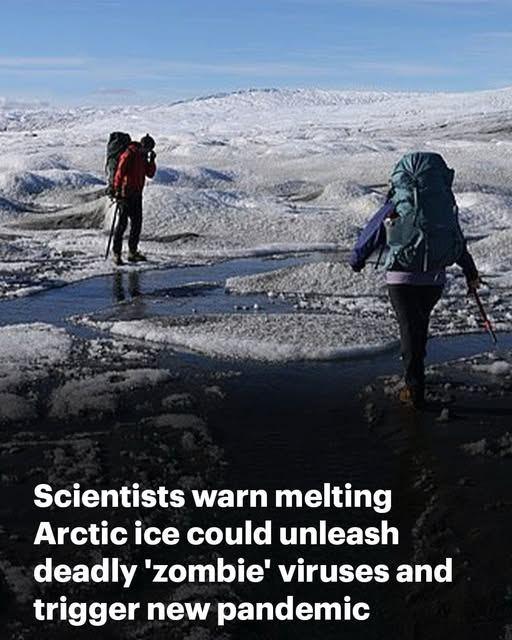The scientific community has been on high alert since the global COVID-19 outbreak, watching the horizon for the next possible pandemic. Unexpectedly, a lot of people now think it might come from the Arctic, one of the coldest and most isolated regions on the planet, rather than from a busy metropolis or animal market.
Glaciers and Arctic permafrost are melting at previously unheard-of speeds as climate change picks up speed. The ancient bacteria that have been frozen for tens of thousands of years are being unlocked by that melting, which is doing more than just releasing water. These germs, which scientists have termed “zombie viruses,” have lay dormant in soil and ice until resurfacing as temperatures rise.

Additionally, several of these extinct organisms have actually been brought back to life.
Researchers have successfully resurrected a number of old viruses from permafrost samples in recent years, which has both fascinated and alarmed people. Among the most well-known are Pacmanvirus lupus, which was recovered from the frozen remains of a 27,000-year-old wolf and also resurrected under controlled laboratory settings, and Pithovirus sibericum, a giant virus discovered in 30,000-year-old Siberian permafrost that was brought back to life in a French lab in 2014. In 2023, researchers studying a Chinese glacier found over 1,700 viruses, many of which had never been identified before.
The fact that these viruses can live and perhaps reactivate is a clear warning, even if they were brought back to life in laboratory and do not currently directly threaten human health. Whether or not ancient infections can reappear is no longer the concern; rather, it is how ready we are in case they do.
It’s not merely science fiction. A lethal epidemic was caused in 2016 when an anthrax-infected reindeer carcass thawed from Siberian permafrost. More than 2,000 reindeer died, several were hospitalized, and one child died. For more than 75 years, the frozen body had been interred. It served as a sobering reminder that infections wait for time to kill them.
Scientists are becoming more concerned about a number of important aspects that contribute to the specific danger of this Arctic menace. Our defenses aren’t prepared. These viruses existed long before the current immune system developed, or they predate contemporary humans. We might not have any biological defenses. They were able to leap from animals to people. This is how many pandemics, including COVID-19, start and is referred to as zoonotic transmission. Wildlife in the Arctic may unintentionally act as hosts for infections that have been resurrected. And the Arctic is not ready. A disease outbreak in this isolated area can go undetected until it spreads around the world due to the lack of adequate healthcare infrastructure. To put it briefly, events that occur in the Arctic don’t remain there. A small epidemic, if not promptly managed, may circle the world in a matter of days because international travel and trade are still close to pre-pandemic levels.
Governments and international health organizations are being urged by researchers to take this issue seriously. This entails providing money for research on Arctic microbiology, keeping an eye out for indications of newly developing infections in permafrost areas, and preparing healthcare systems for illnesses with unknown characteristics. Additionally, it’s another urgent plea to address climate change for the sake of global public health, not only polar bears or rising sea levels. In addition to changing the landscape, each degree of warming may be bringing back long-forgotten dangers.
The idea of ancient viruses emerging from ice may seem unreal in a world still recovering from COVID-19. Scientists, however, are adamant that this scenario is based on facts rather than fiction. And the danger gets closer to reality with every glacier that melts.
